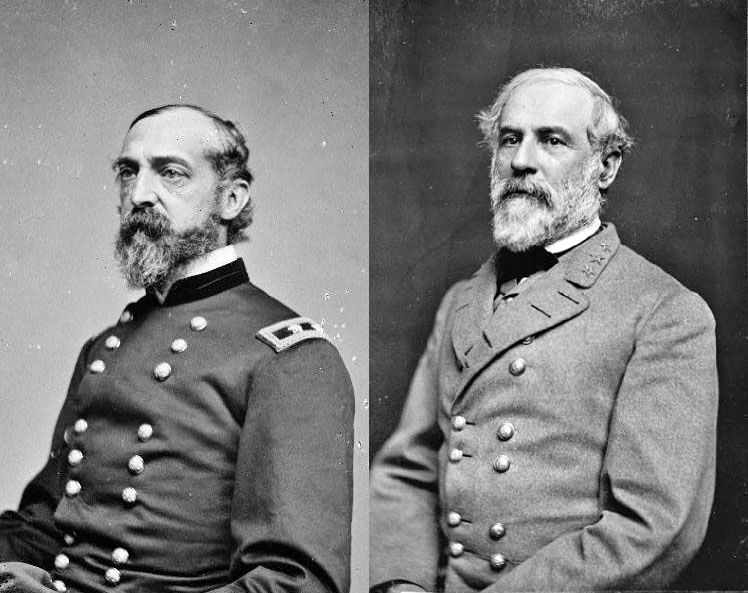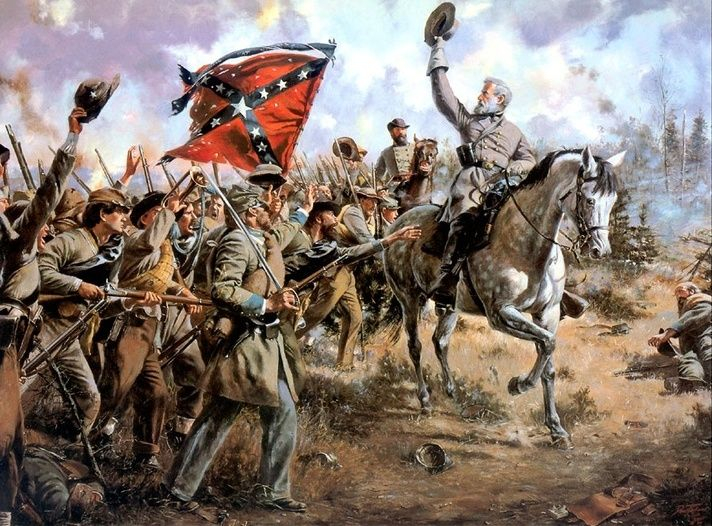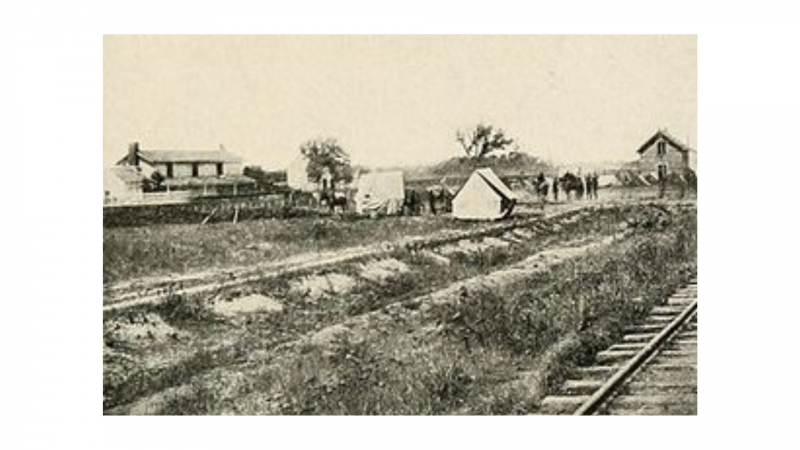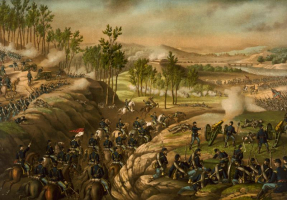Top 8 Facts About The Battle of Rappahannock Station
The Second Battle of Rappahannock Station, fought on November 7, 1863, was the decisive battle of the Bristoe Campaign in Northern Virginia. It is considered ... read more...as an important moment in the Civil War. Let's explore some facts about the battle of Rappahannock Station to know more about it!
-
The first fact in the list of facts about the battle of Rappahannock Station is that the forgotten bristoe campaign's final conflict was the battle of Rappahannock Station. The Bristoe campaign was a series of minor engagements in Virginia in the months of October and November 1863. The Union Army of the Potomac, under the direction of Major General George G. Meade, started to move in an effort to overthrow General Robert E. Lee's Army of Northern Virginia. Meade withdrew his troops back toward Centreville as Lee reacted with a wheeling maneuver. On October 14, Lee attacked Bristoe Station, but he lost two troops and withdrew.
While the nation's attention was diverted to the Western Theater by the Battle of Chickamauga and subsequent action in the area of Chattanooga, Union and Confederate soldiers in the East were engaged in combat in the months that followed the Battle of Gettysburg. Gen. Robert E. Lee launched an offensive in October 1863 in an effort to break the standstill in Virginia. The Army of the Potomac was driven out of Culpeper and Fauquier counties, and the offensive culminated on October 14 with the Battle of Bristoe Station. Following the decisive Confederate defeat at Bristoe, Lee's soldiers withdrew, followed by the Federals who were under pressure from Washington. The Federals learned that the Confederates had erected a defensive line at the Rappahannock River, centered around the hamlet of Rappahannock Station, when General George G. Meade's Army of the Potomac finally caught up with Lee. On November 7, Union forces attacked the Confederate position at Kelly's Ford and Rappahannock Station, forcing the Confederates to flee to the Rapidan River.

Photo: WIkipedia 
Photo: Legends of America -
On November 7, the Rappahannock River was forcibly crossed at two points by the Union forces. More than 1,600 members of Jubal Early's Division were taken prisoner after a nighttime attack that overran the Confederate bridgehead at Rappahannock Station. Kelly's Ford had less intense fighting, with roughly 430 losses, but the Confederates withdrew, allowing the Federals to advance with great might. Lee's army was about to move into winter quarters in Culpeper when they instead retired into Orange County south of the Rapidan River. The area around Brandy Station and Culpeper County was under the control of the Army of the Potomac.
Despite the majority of the Army of Northern Virginia being south of the Rappahannock, the Confederates were still able to access the northern bank of the river thanks to a single pontoon bridge. Lee planned to be able to "threaten any flank movement the enemy could undertake" by holding onto this bridgehead. The overall plan of Robert E. Lee was to make the most of the bridgehead at Rappahannock Station in order to divide any attacking armies, threaten their flanks, and ultimately defeat them. However, Lee's ideas of keeping a presence along the river and in the surrounding area were tarnished once the Federals under Sedgwick took control of the bridgehead. As a result, he was forced to abandon his plans and move even further south to the Rapidan River.

Photo: American Battlefield Trust 
Photo: American Battlefield Trust -
The Louisiana tigers, some of the confederacy's most seasoned soldiers, guarded the rappahannock bridgehead is the next fact about the battle of Rappahannock Station. During the American Civil War, the infantry soldiers from the State of Louisiana who served in the Confederate army were known as Louisiana Tigers. The moniker, which was first used to refer to a particular company, was later extended to a battalion, a brigade, and ultimately to all Louisiana soldiers serving in the Army of Northern Virginia. Although the Louisiana Tigers' precise make-up changed as the war went on, they earned a reputation as fearless, tenacious shock troops.
One pontoon bridge across the Rappahannock River at Rappahannock Station was left standing by Lee in preparation for a spring operation intended to drive the Army of the Potomac out of Northern Virginia. Lee gave the order to build a bridgehead, complete with earthworks and trenches, on the river's north bank in order to defend the bridge. The bridgehead was shielded by artillery batteries on both banks of the river. Lee assigned protection of the bridgehead to Major General Jubal A. Early's Division of Lieutenant General Richard S. Ewell's Second Corps. Brigadier General Harry T. Hays' Louisiana brigade, often known as the Louisiana Tigers, comprised some of Brigadier General Early's best soldiers and manned the position.
North of the Rappahannock, Confederates built earthworks to defend the pontoon bridge. This area was under the command of the irascible Gen. Jubal Early, who was tasked with maintaining the bridgehead. Early assigned the Louisiana Tigers, a brigade under Gen. Harry T. Hays, to carry out this crucial mission. Early could trust Hays' four regiments with a crucial task because they had participated in almost all of the major battles in the east from First Manassas to Gettysburg and had a reputation for fierce combat.

Photo: Angelfire 
Photo: Wikipedia -
Lee predicted that Gen. George G. Meade would divide his troops when he planned his march over the Rappahannock. Five miles downriver from Early's position, the Union Third Corps, commanded by Gen. William H. French, effected a passage at Kelly's Ford. Gen. John Sedgwick's Sixth Corps pushed forward on the bridgehead at Rappahannock Station after engaging French.
The procedure proceeded as planned. On November 7, shortly after noon, French forced the Confederate defenses at Kelly's Ford back and crossed the river. Sedgwick moved in that direction, moving closer to Rappahannock Station. After noon, Lee became aware of these events and instantly ordered his troops to move toward the enemy. His strategy was to assault French at Kelly's Ford with the majority of his army while holding off Sedgwick with a minor force at Rappahannock Station. His ability to protect the Rappahannock Station bridgehead until French was routed was crucial to the strategy's success. At 3 p.m., Maj. Gen. Albion P. Howe's division of the VI Corps drove in Confederate skirmishers and took control of a range of high ground a quarter of a mile from the river, beginning Sedgwick's first engagement with the Confederates. Howe set up Union cannons on these slopes, and they "rapidly and vigorously" fired on the German earthworks. Guns from the Confederacy across the river returned fire, although it had little impact. On that day, the bridgehead defenses were occupied by Maj. Gen. Jubal Early's division. The Louisiana brigade of Brig. Gen. Harry T. Hays and Captain Charles A. Green's four-gun Three North Carolina regiments under the command of Colonel Archibald Godwin were added around 4:30 p.m. to augment the Louisiana Guard Artillery, which was already in action. The number of Confederate defenders at the bridgehead rose to around 2,000 with the arrival of Godwin's forces.

Photo: American Battlefield Trust 
Photo; World History Project -
Throughout the late afternoon, Sedgwick continued to shell the Confederates, but he otherwise exhibited no desire to fight. Sedgwick stationed his artillery on high ground to the north of Rappahannock Station after driving in Early's skirmishers and pounding the Confederate bridgehead. At Kelly's Ford, the entire Union Third Corps moved across the Rappahannock. Lee was certain that Sedgwick's advance was merely a ruse and that French's was the primary assault as night fell. Less than 2,000 soldiers were left at Rappahannock Station, where Lee concentrated on fending off the French. Around dusk, Sedgwick's infantry suddenly surged on the Confederate works while his artillery suddenly went silent. The southerners retreated across the river after being taken by surprise and failing to see any reinforcements. Lee had lost the bridgehead because of his blunder.
Skirmishers from the 6th Maine Infantry advanced before Col. Peter Ellmaker's brigade along the railroad. The National Park Service claims that "no Union unit won more medals that day or lost more soldiers." They rushed over the Confederate lines at the order "Forward, double-quick!" and attacked Hays's men in hand-to-hand fighting. The 6th Maine broke through the Confederate line on their own and raised its flags on the easternmost redoubt's parapet. A short while later, the 5th Wisconsin broke through the western redoubt's fortifications and freed it from Confederate control. That's all about the fifth fact about the battle of Rappahannock Station Toplist want to share!

Photo: Emerging Civil War 
Photo: history.com -
During the American Civil War, the Union Army employed the 6th Maine Infantry Regiment as an infantry regiment. On July 15, 1861, the 6th Maine Infantry was mustered in for a three-year service after being created in Portland, Maine. On August 15, 1864, the 6th Maine Infantry was mustered out of service. Transferred to the 7th Maine Infantry, veterans and recruits eventually merged to form the 1st Maine Veteran Infantry.
The soldiers of Maj. George Fuller's 6th Maine regiment waited after making their first engagement with the enemy as the Sixth Corps artillery hammered the Rebel earthworks. One soldier was killed and five others were injured during the initial advance, which involved only half of the unit. The remainder of Fuller's force advanced at dusk and formed a double skirmish line. The 5th Wisconsin was in close support as the troops of Maine advanced at double quick when the command was given. Confederate musketry "became heavier as the line approached the works, and the troops were struck with terrifying rapidity," according to Fuller. Unfazed, Fuller's men jumped over the Rebel works, sparking a bloody hand-to-hand brawl. According to Fuller, 350 prisoners, a stand of flags, and four pieces of artillery were left behind for the Maine troops when Early's "astonished and bewildered" men fled in disarray toward the adjacent river. At Rappahannock Station, the 6th Maine paid a heavy price for their bravery. The 6th Maine was home to 139 of the 419 Union casualties that day.

Photo: Wikipedia 
Photo: Civil War Talk -
Jubal Early suffered great humiliation as a result of the battle of Rappahannock Station would be the following fact about the battle of Rappahannock Station. Few Confederate Army officers had the standing that Jubal Early did. He had a tendency to triumph even when the odds weren't in his favor, was revered by both Stonewall Jackson and Robert E. Lee, and he had an aggressive streak. However, "Old Jube's" good fortune was scarce on November 7, 1863. North of the Rappahannock, Early's command had less than 2,000 soldiers and only four guns, and they were no match for the unexpected attack that night, which drove his troops from the field. Early's force ultimately suffered 1,670 total casualties, about four times as many as the Union. They also lost all four of Green's battery's guns.
For the South, the conflict had been as embarrassing as it had been for the North. Two of the Confederacy's best brigades had been beaten and captured by an enemy force of comparable size, which had been well-protected by entrenchments and well-supported by artillery. As a result of "miserable, miserable management," Col. Walter H. Taylor of Lee's staff labeled it "the saddest chapter in the history of this army." More succinctly stated was by an enlisted soldier. He admitted, "but it seems to be that our army was surprised”.

Photo: American Battlefield Trust 
Photo: The Reconstruction Era -
On August 23, 1862, in what is now Remington, Virginia, the First Battle of Rappahannock Station took place as a part of the American Civil War's Northern Virginia Campaign. Early in August, Union Maj. Gen. George B. McClellan's army was removed from the Virginia Peninsula to support Union Maj. Gen. John Pope, according to Confederate Gen. Robert E. Lee. He dispatched Thomas J. with a wing of Maj. Gen. James Longstreet from Richmond. On August 15, "Stonewall" Jackson traveled to Gordonsville to assume command of the troops under his command. Pope withdrew to the edge of the Rappahannock River on August 20 and 21.
Gen. Robert E. Lee sent Gen. James Longstreet's wing of the Army of Northern Virginia from Richmond to join Gen. Thomas J. Jackson's in the area of Gordonsville after becoming convinced that Gen. George B. McClellan's Union army was being withdrawn from the Peninsula to support the newly organized Federal army led by Gen. John Pope. Pope's Yankees moved to a new defensive position on the Rappahannock River after losing to Cedar Mountain. Gen. J.E.B. Stuart's Confederate cavalry raid exposed the Union right flank's weakness. Along the Rappahannock River, Pope's soldiers and Longstreet's men engaged in a few small-scale battles over the period of several days. These engagements only resulted in a few hundred deaths, but they managed to keep the Federals in place, allowing Jackson to take Manassas Junction and Bristoe Station.

Photo: Wikipedia 
Photo: American Battlefield Trust





























